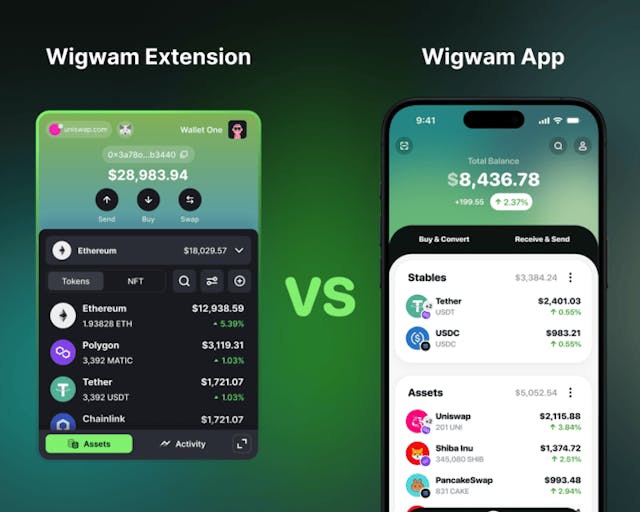DeFi platforms have already proven to be a powerful alternative to traditional financial instruments due to their immutability, transparency and higher returns.
According to Zion Market Research, DeFi market size is projected to reach $232.20 billion by the end of 2030.
Statista says that the average revenue per user in the DeFi space stands at $1,378.00 in 2024 (the amount of revenue divided by number of users.) A comparatively low threshold unlike in traditional banking makes DeFi more democratic and an equal financial instrument for passive income with 24/7 market availability.
This revenue includes different ways of earning: staking, farming, lending borrowing and many more. In this article, we’ll review the main ways to earn on DeFi in 2024.
Before you start reading:
We advise you to use the Wigwam app for all your airdrop activities. This wallet allows you to connect to any Web3 dApps, gives you instant access to almost all tokens on the market with the ability to buy or sell any of them, and lets you earn crypto while trading inside the wallet. Check it out on your mobile now.
1. Liquidity providing
Giving liquidity to popular DEXes like Uniswap, dYdX, PancakeSwap and others is one of the simplest and most popular strategies. It’s a win-win situation when locking up assets in a pool you provide a DeFi platform with liquidity, improve and speed up trades and the overall platform’s performance.
And, of course, you receive a portion of the fee when users swap the two tokens that are in the pool.
For instance, you select the ETH/USDT pair and enter the number of tokens you’d like to add (if it’s a stable pair - choose 0.01%) which is the best for stable pairs.
In return, you’ll receive LP tokens representing their amount (share) in the liquidity pool. After, you can always withdraw these tokens along with revenues generated from swaps which can sum up to a considerable amount of tokens.
Beware of Impermanent Loss, as the price of your allocated assets may change from the time you allocated them. Thus, you’ll need to wait at least while the token price returns to its original value before withdrawing your assets.
2. Yield farming
It’s another step after providing liquidity to the pool. As soon as you get LP tokens, you can lock them up in specific pools to get the highest rewards. Usually yield farming combines both staking and liquidity provision. However, different platforms may offer other yield-generating activities to generate income.
First, check all the opportunities on the market. Explore yield info on different platforms and choose the most profitable opportunity. For this purpose, use such popular analytic tools like De.Fi that provide unified data for the most popular DeFi protocols.
3. Lending and borrowing
You can also earn interest through lending your digital assets to users on DeFi platforms. Just simply choose the token you’d like to lock and explore the conditions of lending.
Usually, Annual Percentage Yields (APYs) in DeFi are much higher than that in traditional lending instruments (1% to over 20%, depending on the platform and the popularity of the asset), so it’s a great and profitable way to get passive income in DeFi.
Feel free to use these assets afterward as loans and pay back interest when borrowing funds.
Take into account that usually borrowing services are available only in case you already supplied an asset as a collateral to the platform (just as many other DeFi platforms.)
4. Staking
If you lock tokens into smart contracts, you can get great passive income for some time. It refers to opening savings accounts in traditional banking. There are 2 main types of staking: Proof-of-Stake (PoS) and Incentives staking.
The first one implies validating transactions through transferring a certain amount of tokens to a delegate. Explore all the staking possibilities on different protocols. Different platforms give different APY. For instance, Binance offers SOL: 7% APY and MATIC: 10% APY while Coinbase offers SOL 5.55%, and MATIC 3.45%. However, it’s crucial to take into account the waiting periods before assets can be unstaked. Weight everything before making the final decision.
Incentive staking offers to earn rewards for holding a certain type of token for a longer period. The longer your lockup period is, the higher the return rate you get. Sometimes Incentive Staking can happen without a lockup period.
5. Vaults (Yield optimizers)
Sometimes users may feel a lack of knowledge and experience regarding DeFi revenues. Vaults can be of great help in this case. These are automated investment platforms that use pre-defined strategies to generate returns.
Different vaults offer investing and reinvesting funds on numerous DeFi protocols and blockchains.
Such platforms as Beefy protocol, maximize the rewards available to users from liquidity pools (LPs), automated market makers (AMMs), and other trading platforms. By using vaults, you save time and money: you don't have to manually manage your position - it's all done automatically and at a higher frequency, reducing countless small transactions and their gas costs.
6. Other ways
DeFi opens up numerous opportunities. Some platforms also offer to farm governance tokens by taking part in the governance of DeFi protocols. You can earn great interest if the protocol/platform offering tokens turns out to be successful.
Some platforms also offer synthetic assets that copy the value of physical assets and, thus, open up new opportunities for the DeFi audience. Briefly saying, synthetic assets are derivatives that can be useful if you want to profit from the price fluctuations of a stock that you don’t own.
No matter which way you choose, always take into account that DeFi works best if you DYOR thoroughly first and weigh all the opportunities.
Always take into account that DeFi sphere is connected with risks, including smart contract vulnerabilities, market volatility, impermanent loss and numerous scams. Choose wisely and good luck!




